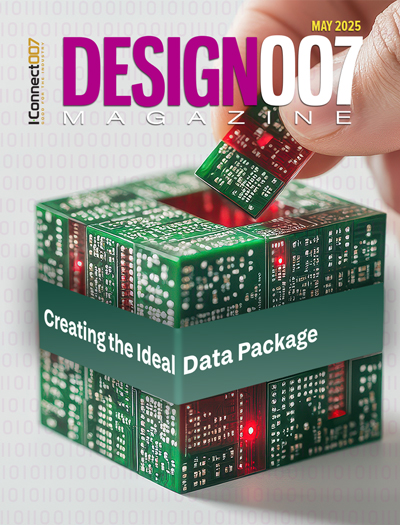-

- News
- Books
Featured Books
- design007 Magazine
Latest Issues
Current Issue
Creating the Ideal Data Package
Why is it so difficult to create the ideal data package? Many of these simple errors can be alleviated by paying attention to detail—and knowing what issues to look out for. So, this month, our experts weigh in on the best practices for creating the ideal design data package for your design.

Designing Through the Noise
Our experts discuss the constantly evolving world of RF design, including the many tradeoffs, material considerations, and design tips and techniques that designers and design engineers need to know to succeed in this high-frequency realm.

Learning to Speak ‘Fab’
Our expert contributors clear up many of the miscommunication problems between PCB designers and their fab and assembly stakeholders. As you will see, a little extra planning early in the design cycle can go a long way toward maintaining open lines of communication with the fab and assembly folks.
- Articles
- Columns
Search Console
- Links
- Media kit
||| MENU - design007 Magazine
How to Successfully Purchase PCBs
June 8, 2015 | NCAB GroupEstimated reading time: 1 minute
How do you go about purchasing reliable and durable PCBs at the lowest possible cost? A key success factor is to provide the prospective suppliers with accurate and clear specifications, and to keep a close eye on the quality of the boards once they are in production. This in turn requires the parties involved to establish and maintain a close and efficient dialogue to ensure that the process builds on correct and relevant information.
PCBs are not standard components and thus not an easy product to purchase. The cost is determined to a large extent, by the complexity of the design.
”This means that factors determining the costs of a new PCB are established at a very early stage, long before the buyer has started asking for quotations from prospective suppliers. The major proportion of the cost is determined already at the engineering and design phase,”says Bo Andersson, technical manager at the NCAB Group. The best way of reducing costs is to think in terms of volume right from the start. You should start gathering appropriate data from the EMS and PCB suppliers at the design stage; this to enable the boards to be optimized for series production, taking into account what they are they going to be used for.
”There is a great deal to be gained by looking twice at such factors as the material and technical specifications, for example track and gap, tolerances and aspect ratios. It can, in some cases be extremely difficult and costly to put right design solutions that haven’t been optimised before they go into production. For example, an unnecessarily high aspect ratio affects so many parameters that it can be extremely time consuming to correct. I know of a case where it took a year to put right design shortcomings, since almost all the PCBs needed to be redesigned,” says Andersson.
”Issues that may lead to unnecessary costs can often be corrected. It is important to familiarize yourself with and get a firm grasp of the specific requirements, and then work to achieve those requirements,” he observes.
Suggested Items
Flexible PCB Market to Reach $61.75B by 2032, Driven by the Demand for Compact Electronics, Automotive and Medical Applications
05/16/2025 | Globe NewswireAccording to the SNS Insider, “The Flexible PCB Market was valued at USD 21.42 billion in 2023 and is expected to reach $61.75 billion by 2032, growing at a CAGR of 12.52% over the forecast period 2024-2032.”
I-Connect007 Editor’s Choice: Five Must-Reads for the Week
05/16/2025 | Nolan Johnson, I-Connect007My picks for the week include—as a complement to the trade agreement news—SEMI's public support of a bill including new tax credit eligibility for semiconductor manufacturers. This provision feels quite similar to the current PCB investment bill that's been introduced to the current Congress; here’s hoping Congress takes a more holistic approach to electronics manufacturing.
The ICAPE Group Announces a 13% Growth in Revenue to €51.1M for Q1 2025
05/15/2025 | ICAPE GroupThe ICAPE Group, a global technology distributor of printed circuit boards (PCB) and custom-made electromechanical parts, announced its sales for the first quarter of 2025.
In Pursuit of Perfection: Defect Reduction—May 2025 PCB007 Magazine Now Available
05/15/2025 | I-Connect007 Editorial TeamFor bare PCB board fabrication, defect reduction is a critical aspect of a company's bottom line profitability. In the May 2025 issue of PCB007 Magazine, we examine the imaging, etching, and plating processes, as well as product traceability on the shop floor, providing information and insight into how you can reduce your defects and increase yields.
Canadian Circuits Inc. Unveils Rapid Prototype PCB Assembly Service to Accelerate Innovation
05/14/2025 | Canadian Circuits, Inc.Canadian Circuits Inc. (CCI), a leading provider of high-quality, made-in-Canada, Printed Circuit Board (PCB) solutions, is proud to announce the launch of its Prototype PCB Assembly (PCBA) service. This new offering enhances CCI’s commitment to empowering engineers and OEMs by accelerating the journey from concept to product launch with precision and efficiency in electronics manufacturing.


